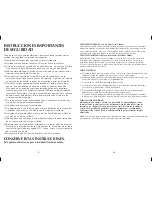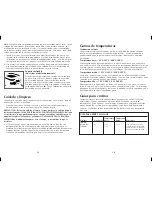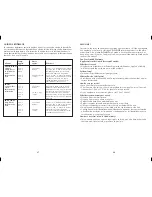
4
3
1. Skillet pan
† 2. Glass lid (Part # SK200C-01)
3. Vent
4. Lid handle
† 5. Handles (Part# 177804-00)
6. Probe/plug
† 7. Variable temperature control (Part# 177805-00)
8. Temperature control/signal light
Note: †
indicates consumer replaceable/removable parts
Product may vary slightly from what is illustrated.
How To Use
This product is for household use only.
ASSEMBLE BEFORE FIRST USE
1. Place the skillet pan upside down on a table or counter and remove the screws.
Be sure the metal washers remain in place over the holes.
2. Position each handle overhanging the edge of the counter for easier assembly so
that the holes in the handles line up with the holes in the raised “mounting” area
on the bottom of the skillet pan.
“Conditioning” The Pan
Important: Before first use, remove the control and wash the skillet pan and
lid in soapy water; dry thoroughly. To preserve the nonstick coating, condition
the pan by spreading a light coating of cooking oil over the inside surfaces.
Wipe away excess oil with a paper towel. Do not use nonstick cooking spray to
condition. You will not have to re-condition again after first use.
Note:
Only use the temperature control provided with this skillet. Other controls
may fit but will not provide proper performance.
1. Set the temperature control to “Off” and push the
probe firmly into the socket on the skillet pan
(A)
.
Be sure the control is securely inserted. Always
attach the control to the pan FIRST before plugging
into an outlet.
2. Preheat the skillet pan before adding any grease or
vegetable oil unless the recipe says to add fats first.
Some foods do not require skillet preheating. Use the charts in this book as
a guide for procedures. To preheat the skillet, turn the temperature control
knob to the recommended setting. When the signal light goes out, the skillet is
preheated. During cooking, the signal light will cycle on and off indicating that
the temperature selected is being maintained.
3. Some recipes call for simmering which means to cook foods in liquid just
below the boiling point. The simmer point varies depending on the type of
liquid and amount of food. To simmer, bring the food or liquid to a boil by
turning the temperature control knob to around 350°F (177°C). When the
liquid begins to boil,
slowly
turn the control knob back until the signal light
goes out. Cover and simmer for the length of time necessary. The light will
cycle on and off frequently to maintain the simmer temperature.
4. While the handles and base “feet” are heat-resistant, do not cook on heat-
sensitive surfaces. Once cooking is complete, you can remove the control to
bring the skillet pan to a table for easy serving. To remove, be sure the control
is unplugged and set at Off. Using a pot holder or mitt, hold the Skillet with
one hand and the pull the temperature control out from the pan with the other.
Note:
Some counter and table surfaces are sensitive to heat. Take care to avoid
damaging linoleum, vinyl tile, painted or varnished surfaces. Heat-resistant
formica and porcelain enamel surfaces are not affected providing the underside of
the pan is clean. When in doubt, use a heat-resistant pad or hot plate under the
skillet.
A



































